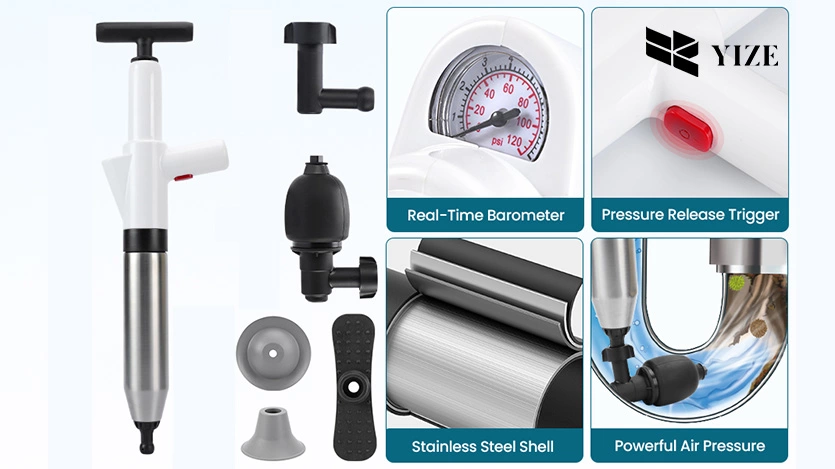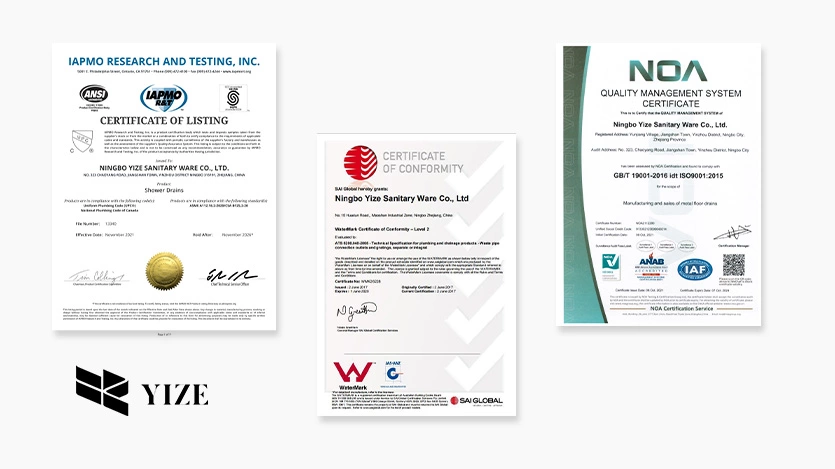
I. Introduction
If your shower drain is clogged, then expect to have a troublesome and messy problem on your hands. Not only does excess water create a situation that prevents a normal workflow, but it also leads to unsanitary conditions. Seemingly, dealing with standing water is very important, especially if you do not want to experience stink, bacteria formation, or harm to your pipes. The following part of the article describes the process of how to and steps to prevent the shower drain from being clogged.
1. Common Issue of Clogged Shower Drains Leading to Standing Water
Hair, soap scum and other grime are some of the usual causes to a blocked shower drainage. These materials gradually build up, which reduces the ability of water to drain and leaves stagnation in the shower area. If left unresolved, the problem progresses, leading to complete blockage, that’s why the complex problems of the plumbing occur.
2. Importance of Addressing the Problem Promptly
Any remains of standing water in your shower may have drastic effects in the long run. Standing water promotes the formation of bacteria molds produces bad odours and brings about health risks. Early action assists in upholding cleanliness and also guarantees that your plumbing system is in the right state.
II. Understanding Why Water Sits in the Shower Drain
Common causes of clogged shower drains leading to standing water
- Hair: Bits of hair fall and combine together as well as can build up to clog the flow of water.
- Soap Scum: soap forms a scum with minerals found in water, making them sticky.
- Mineral Deposits: It’s noteworthy that hard water causes mineral buildup that reduces the diameter of the drainpipe.
- Foreign Objects: Easily removable objects like hair, pieces of food, small toys or any other small object can cause blockage when accidentally dropped into the drain.
Potential Issues with the Drain Design or Installation
Not always the issue is only debris; it can be a lot worse. Shower drains that have been installed poorly or which are of low quality are most likely to develop blockages. Solutions to clogs might be low-grade materials used, lack of proper pipe slope, and small pipes, all of which will worsen drainage.
III. Preparing to Unclog Your Shower Drain
1. Assessing the Situation
- Notice the sluggish speed at which the water drains, if it does at all.
- First go around the sink and look for any visibility debris near the drain cover.
- Any strange smells that might be a sign of serious blockage should be taken note of.
2. Gathering Necessary Tools and Materials
- Plunger
- Drain snake or auger
- Baking soda and vinegar
- Wet/dry vacuum
- Pliers or a hook
- Rubber gloves
- Bucket and rags
3. Safety Precautions
(1)Protecting Your Hands and Eyes
- Wear rubber gloves since you’re likely to come across debris and bacteria with your hands.
- Wear safety goggles if working with solutions that may splatter.
(2)Avoiding Harsh Chemical Drain Cleaners
- Grates can degrade pipes when they are chemically cleaned, especially for older pipes.
- Turn down synthetic methods or contact with chemicals in order to minimize health and impact on the environment
IV. Methods to Unclog a Shower Drain with Full Water

1. Method 1: Using a Plunger
The plunger is easy and effective for clearing blockages close to the drain hole as compared to other tools.
(1)Step-by-Step Guide:
- The position plunger should be placed over the drain and make sure it is sealed firmly.
- Submerge the plunger cup in water right up to the edge in order to get a better suction.
- Pull and push the plunger in a forceful motion for 1/2 a minute.
- Take out the plunger and see if the water comes out.
(2)Tips for Maximizing Suction:
- It is advised to lubricate the rim of the plunger with petroleum jelly to make it form a better seal.
- Try to build up good pressure with short, quick actions.
2. Method 2: Drain Snake or Auger
A drain snake can deal with the clogs farther down the pipe and was designed to help with this problem.
(1)How to Use a Drain Snake:
- Place the snake into the drain and after some struggle, stop and leave the pipe head.
- Twist it around this handle in order to destroy the clog.
- Slowly pull the snake out, that will help to clear the debris.
(2)Preventing Damage:
- Do not try to force the snake into the drain because it will scratch up the pipe.
- Wash the snake after it has been used to reduce on the spread of bacteria among people.
3. Method 3: Homemade Solutions
Simple and readily available household products such as baking soda and vinegar are efficient products to clear clogs.
(1)Steps to Create and Apply the Mixture:
- For one cup, pour baking soda directly into the drain.
- Follow with 1 cup of vinegar.
- This is by covering the drain to allow the reaction to work on other aspects of the case.
- After that, let it sit for fifteen to twenty minutes before you rinse with hot water.
(2)Allowing Time for the Solution to Work:
This should be followed by allowing the solution to stand still for sometime to accomplish the cleaning of grease and other residues.
4. Method 4: Wet/Dry Vacuum
You get a wet /dry vacuum which is effective in sucking off clogs that may be deep.
(1)Setting Up the Vacuum:
- Put a vacuum suit for liquid suction.
- It reduces the water suction rate through the drain when sealing the latter with a wet cloth.
(2)Ensuring Effective Suction:
- Switch the device to the maximum power mode.
- Wipe the vacuum nozzle side to side in order to remove dirt.
5. Method 5: Removing the Drain Cover and Manual Extraction
Sometimes, you need to get hands-on with the clog.
(1)How to Safely Remove the Drain Cover:
- Proceed to unscrew the cover or simply pry it off using the sides of a flat-edged screwdriver.
- Lay the cover apart on a towel in order to keep the surface of the furniture clean.
(2)Pulling Out Hair and Debris:
- To remove large masses of hair and debris, use pliers or a hook.
- Toss waste in a bucket so as not to spill and slop all over the place.
V. Preventing Future Clogs
1. Regular Maintenance Tips
Routine Cleaning and Inspection:
- Scrub the drain with water at least once a week to clear small particles.
- The clogs are best dealt with early and this can be ascertained by looking for signs of slow drainage in the showers.
Products That Help Prevent Clogs:
It is recommended to install sophisticated shower drains such as YZDRAIN, which feature a design that enhances ease when cleaning.
2. Using Drain Screens
Drain screens were installed at the entrance of the pipe to retrieve hair and other trash materials.
Importance of a Good Drain Screen:
- Avert deposition of the bigger particles.
- Requires lesser deep cleaning than the other types of cleaning.
3. Recommendations for High-Quality Screens:
- In terms of screen, choose a stainless steel screen for it is rather durable.
- Select screens with spaces small enough to capture particles you expect to ensnare.-
VI. Why Choose YZDRAIN for Your Drain Solutions?

YZDRAIN makes custom shower drains with additional benefits for easy cleaning and avoiding blockages.
Key Features:
- Anti-clog hoods are devices that restrict debris from accumulating.
- This applies towards component quality, where high-quality material would mean that the product is long-lasting.
- Taint-resistant designs are less time-consuming to clean hence suitable.
It is evident that homeowners and plumbers find YZDRAIN products not only sleek and practical but also effective. Some of these emphasize their capacity to minimize the blocking of the water drain and enhance the flow of water.
VII. Conclusion
In most instances, you’ll find a shower drain that is full of standing water and this, therefore, makes it difficult to get it unclogged. Causes of stopped-up shower drains and successful methods of treating them include using a plunger, drain snake, or homemade solution. In conclusion, it is recommended that proper maintenance should be developed and start or change to high-quality products such as YZDRAIN. It does not take much to maintain and ensure that your shower drain is clean and does not cause you a lot of trouble.
Frequently Asked Questions (FAQs)
Q1: What causes a shower drain to clog?
Soap, hair, and mineral buildup usually get stuck in the pipes of shower drains.
Q2: Can I use chemical drain cleaners for clogs?
Do not use chemicals that are very toxic since they can eat through the pipes and pollute water. Making them a poor choice for most clogs and often leading to more expensive repairs in the future; it’s best to try safer methods or call a plumber for significant clogs.
Q3: Will baking soda and vinegar unclog a drain with standing water?
Yes, baking soda and vinegar can help unclog a drain with standing water, but it’s best for weaker clogs:
– Step 1: Remove standing water: Use a bucket to remove as much standing water as possible.
– Step 2: Pour baking soda and vinegar: Pour 1/2 cup of baking soda down the drain, then slowly pour in 1/2 cup of vinegar.
– Step 3: Cover the drain: Cover the drain with a clean cloth or drain plug to enhance the foaming action.
– Step 4: Let it sit: Let the mixture sit for about 30 minutes.
– Step 5: Rinse with hot water: Rinse the drain with hot water to flush away any remaining residue.
Q4: How do you unclog a severely clogged drain?
If a drain is severely clogged, it may require more aggressive methods:
– Step 1: Use a drain snake or auger to break up the clog deep inside the drain.
– Step 2: For very tough clogs, consider using a high-pressure water jet to clear the pipe.
– Step 3: If all else fails, calling a professional plumber might be the best solution to avoid pipe damage.
